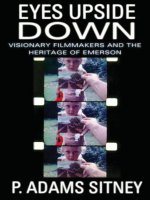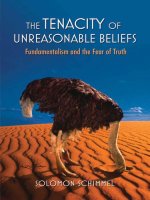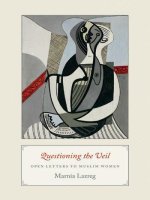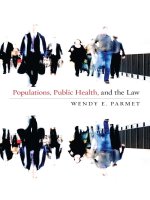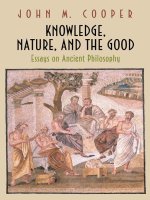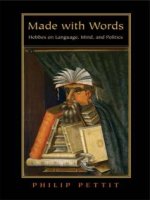princeton university press apocalypse earthquakes archaeology and the wrath of god mar 2008
Bạn đang xem bản rút gọn của tài liệu. Xem và tải ngay bản đầy đủ của tài liệu tại đây (6.5 MB, 319 trang )
Apocalypse
Q
Nur_00fm.indd i
9/10/2007 7:49:47 AM
A
Deaths per Earthquake
50 - 500
500 - 5000
5000 - 50000
50000 - 500000
500000 - 830000
B
Rome Mycenae
San Francisco
Tangshan
Lisbon
Troy
Teotihuac·n
Teotihuac
Caracas
Lima
Luxor
Jericho
Bam
Tokyo
Killari
Sumatra
Lago Budi
Frontispiece. Geographic relation between earthquakes and archaeology: (a) the
most deadly earthquakes in the world between AD 1500 and 2000 (after Agnew
2001); (b) some of the cities and archaeological sites mentioned in this book
where earthquakes had a major impact on society.
Nur_00fm.indd ii
9/10/2007 7:49:48 AM
Apocal ypse
Q
E A R T H Q U A K E S , A R C H A E O L O G Y,
AND THE WRATH OF GOD
Amos Nur
with Dawn Burgess
PRINCETON UNIVERSITY PRESS
PRINCETON AND OXFORD
Nur_00fm.indd iii
9/10/2007 7:49:48 AM
Copyright © 2008 by Princeton University Press
Published by Princeton University Press, 41 William Street, Princeton, New Jersey 08540
In the United Kingdom: Princeton University Press, 3 Market Place, Woodstock,
Oxfordshire OX20 1SY
All Rights Reserved
ISBN-13: 978-0-691-01602-3
British Library Cataloging-in-Publication Data is available
This book has been composed in Sabon with Galahad Regular Display
Printed on acid-free paper. ∞
press.princeton.edu
Printed in the United States of America
1 3 5 7 9 10 8 6 4 2
10 9 8 7 6 5 4 3 2 1
Nur_00fm.indd iv
9/10/2007 7:49:48 AM
And they assembled them at the place that in Hebrew is called
Armageddon . . . and there came . . . a violent earthquake, such as had
not occurred since people were upon the earth, so violent was that
earthquake: And the great city was split into three parts, and the cities
of the nations fell. . . And every island fled away, and no mountains
were to be found.
—Book of Revelation, 16:18–20
Q
Nur_00fm.indd v
9/10/2007 7:49:48 AM
Nur_00fm.indd vi
9/10/2007 7:49:48 AM
C O N T E N T S
Q
Acknowledgements
Introduction
ix
1
Chapter 1
King Agamemnon’s Capital
11
Chapter 2
How Earthquakes Happen
32
Cha pter 3
History, Myth, and the Reliability of the
Written Record 65
Chapter 4
Clues to Earthquakes in the Archaeological
Record 88
Chapter 5
Under the Rubble: Human Casualties of
Earthquakes 141
Cha pter 6
Qumran and the Dead Sea Scrolls: Destruction
That Preserves? 162
Chapter 7
Expanding the Earthquake Record in the
Holy Land 186
Nur_00fm.indd vii
9/10/2007 7:49:48 AM
viii
Contents
Chapter 8
Earthquake Storms and the Catastrophic End of the
Bronze Age 224
Chapter 9
Rumblings and Revolutions: Political Effects
of Earthquakes 246
Chapter 10
Earthquakes and Societal Collapse
279
Glossar y
References
Index
Nur_00fm.indd viii
272
289
305
9/10/2007 7:49:48 AM
A C K N O W L E D G M E N T S
Q
T
his book tours the evidence for earthquakes in various famous archaeological and historical sites, mostly in the Mediterranean region, and correlates the suspected earthquake damage
to the known seismic risks of each site. In some cases there are
written records of varying reliability; in others there is physical
evidence of earthquake occurrence; still others exhibit only suggestive evidence and a candidate fault nearby. Every case is controversial, and this book tries to examine both the causes of the
controversy and the far-reaching effects of earthquakes on human
society.
One of the greatest challenges I faced in writing this book was its
interdisciplinary—or, more precisely, multidisciplinary—nature.
“Interdisciplinary” is a buzzword these days in academia in general, and particularly at Stanford University. It is an appealing idea
that is easy to explain but often difficult to execute. A key problem
is the need for an investigator or a writer to be able to span several
disciplines reliably when he or she is an expert in only one. In my
case, I found that branching out from earth sciences (which is my
core area of expertise) to archaeology, history, mythology, and
social sciences was a risky business. It was not only criticism from
others that made me nervous about publishing my ideas but my
worry that my knowledge and therefore understanding in those
disciplines is incomplete. To compensate for this deficiency—at
least in part—I read a lot, and, most important, received encouragement and advice from friends and colleagues outside the earth
sciences.
Nur_00fm.indd ix
9/10/2007 7:49:48 AM
x
Acknowledgments
I am indebted to many individuals who, over the past few years,
have made it possible for me to write this book. First, I thank
those who introduced me to the potential as well as the difficulties of linking earthquakes, archaeology, and mythology to societal and political issues. In 1973, Professor Ari Ben Menahem at
the Weizmann Institute of Israel opened my eyes to the richness
of archaeological and textual evidence for past earthquakes along
the Dead Sea Fault. I also owe a great debt to Professor Nicholas Ambraseys (Imperial College, London). His prolific work is an
amazing accomplishment, compiling and evaluating some twentyfive hundred years of textual references to past earthquakes and
some of the damage they caused. Even though he was (and, I fear,
remains) a staunch skeptic of the value of available archaeological
information and a tough critic of what I have tried to develop over
the years, I found his work invaluable.
The broadest and deepest contribution to my understanding of
the impacts of past earthquakes on history (and, indirectly, archaeology) was from my friend Emanuela Guidoboni from Bologna,
Italy. Her monumental works summarizing earthquakes in the history of the Mediterranean region and the Middle East served as
a never-ending source of facts and inspiration. I see my book as
a modest attempt to bring to the wider public some of the great
work that Emanuela did.
Then there are those who helped and collaborated in several aspects of the work that led to my writing this book: Professor Hagai
Ron (Hebrew University, Jerusalem) was my early collaborator
and partner in exploring the effects of earthquakes on ancient sites
in Israel and Jordan. Hagai introduced me to many archaeological sites that I did not know about. Together we produced the
documentary And the Walls Came Tumbling Down, where we
described the impact of past earthquakes in the Holy Land dating back to early biblical times. We also published several papers
together on the same topics, including “Armageddon’s Earthquakes,” which is the basis for parts of chapter 7. Another activity
we shared was taking Stanford students on field trips to many of
the sites mentioned in this book. Professors Shmulik Marco and
Nur_00fm.indd x
9/10/2007 7:49:48 AM
Acknowledgments
xi
Zvi Ben Avraham of Tel Aviv University, Israel, Amotz Agnon,
of Hebrew University, and Zeev Reches, now at the University of
Oklahoma, were involved in site visits and related work throughout Israel. Professor Renato Funicello of the University of Roma
III helped me discover archaeological effects of past earthquakes in
Rome and throughout Italy in general. Professor Eric Cline, now
at George Washington University in Washington, D.C., published
a paper with me entitled “Poseidon’s Horses: Plate Tectonics and
Earthquake Storms in the Late Bronze Age Aegean and Eastern
Mediterranean,” which was the basis for chapter 8 of this book.
My colleague at Stanford University, Professor Robert Kovach,
introduced me to many sites and facts related to earthquakes in the
Americas, including exciting sites in Mexico.
I am also grateful to the many Stanford undergraduate students
who, over a five-year period, not only patiently attended my lectures on earthquakes and archaeology but also contributed to this
work with their post–field-trip term projects and presentations on
sites in Israel, Jordan, Greece, Turkey, Italy, and Mexico. I also
thank Lynn Orr, Susan Orr, and Helen Bing for their encouraging
support and participation in some of these trips.
Professor Jean Marie Apostolides of Stanford University continuously urged me to write this book, and encouraged me to overcome my interdisciplinary worries.
This book would never have materialized without the dedicated
work of my former graduate student, collaborator, researcher, editor, and co-writer Dawn Burgess. Her talent and patience helped
transform my scattered writings, class notes, video transcripts, and
early drafts into a book. My assistant, Girley Tegama, at Stanford
University, has tirelessly sorted out references and illustrations.
She has also uncovered leads to materials that were unknown to
me. Her dedication to this project has been admirable.
I am also grateful to the earlier help of Margaret Muir at Stanford University, who patiently helped in the initiation of this project, and to Carlo Di Bonito who so generously created the graphics
for this book. Carlo helped transform complicated material into
clear, understandable visual presentations.
Nur_00fm.indd xi
9/10/2007 7:49:48 AM
xii
Acknowledgments
The most sustained support for this book came from Francina
Nur, my wife, who has shared with me the discovery of earthquake evidence in field trips to many of the sites referred to in this
book. Most important, she tirelessly and patiently encouraged me
to complete the project.
Stanford, California, January 22, 2007
Nur_00fm.indd xii
9/10/2007 7:49:48 AM
Apocalypse
Nur_00fm.indd xiii
9/10/2007 7:49:48 AM
Nur_00fm.indd xiv
9/10/2007 7:49:48 AM
I N T R O D U C T I O N
Q
Civilization exists by geological consent, subject to change
without notice
—Attributed to Will Durant [US Historian 1885–1981]
by Robert Byrne (1988)
T
he insight displayed by the quote above becomes clear when
we combine archeology with earthquake sciences to illuminate the
fates of abandoned cities and extinct civilizations. This book was
written to explore how earthquakes in the distant past influenced
what we have uncovered in archeological sites, and to speculate
on the societal, political, and economic repercussions that affected
later societies.
Using archeological evidence for the catastrophic, physical collapse of buildings, entire cities, or geographical regions to infer
that earthquakes were responsible for the devastation is actually a
simple idea but one that yields compelling data. This is especially
so in regions where, based on modern geological and seismological data, large earthquakes have repeatedly occurred. It would be
ludicrous, for example, to question whether Jericho—2 kilometers from the Dead Sea Fault, the Near East equivalent of California’s San Andreas Fault—was destroyed repeatedly by large
earthquakes; the question should be which of the earthquakes that
struck the area hit when the city was occupied and which when it
was abandoned.
Nur_00int.indd 1
9/10/2007 7:52:40 AM
2
Introduction
Many ruins uncovered by archeological excavations in earthquake-prone regions are the partial result of past earthquakes. The
heavy structures of antiquity were designed to support their own
vertical weight, but not to withstand the sudden, horizontal ground
acceleration that occurs in destructive earthquakes. The Eastern
Mediterranean and Near East offer some of the most spectacular
examples. Traveling in those parts, one cannot fail to recognize
the preponderance of ruins, the many sites that were destroyed
and rebuilt again and again. Why are there so many ruins? Is it
the result of wars? The passage of time? No, most of this damage
is because of earthquakes. The most popular and spectacular sites
have succumbed repeatedly to seismic damage: Jericho, Troy, Mycenae, Petra, Knossos, Qumran, Susita, Bet Shean, Jerash, Luxor,
and Armageddon, to name a few of the most famous.
We know from modern geological and geophysical research
that the Eastern Mediterranean and Near East have experienced
a great many earthquakes over hundreds of thousands or even
millions of years. The same region has also witnessed, over this
vast period, ongoing human settlement and development, and the
emergence of great civilizations that created massive structures,
including fortifications, palaces, temples, aqueducts, and large masonry bridges. The larger these structures became, however, the
more vulnerable they were to damage, if not complete destruction, by sudden earthquakes. The social systems that created these
structures may have depended on them for governance and stability, and so the physical destruction of these structures could lead
to the collapse of the corresponding social orders. I believe this
occasionally happened.
This idea is an example of “catastrophism,” the sudden, typically unpredicted natural disaster that leads to abrupt changes in a
culture or lifestyle that has been stable for a long time. Following
such catastrophes, an entirely new societal, political, or military
order can emerge, as seems to have happened when classical Greek
culture emerged from its dark ages following the catastrophic collapse at the end of the Bronze Age. Sometimes the only traces of
Nur_00int.indd 2
9/10/2007 7:52:40 AM
Introduction
3
these sudden upheavals are ruins that remind us that what was
once prominent, powerful, and stable has suddenly disappeared.
For example, the destruction of the Ramsmuseum and Ramses II
statue in the first century BC, as commemorated in Shelley’s Ozimandias, was surely caused by an earthquake in the Luxor-Thebes
area of Central Egypt.
Although these are simple concepts, the idea that earthquakes
played an important role in some catastrophic changes in our
past—whether in the Eastern Mediterranean and the Near East
or in Central and South America—has received stiff opposition.
This opposition is, in part, a predictable, professional territorial
issue: archaeologists do not want geophysicists to invade their
excavations and interpretations, and some historians tend to be
skeptical of evidence that is not textual. However, there is a more
philosophical aspect that I call the “problem of proof.” Mark
Rose (1999), the editor of Archeology, had the following response
to my paper (Nur 1998), which discussed the role of earthquakes
in the cataclysmic end of the Bronze Age:
It isn’t enough to say that the North Anatolian Fault is dangerous and
might have unzipped between 1225 and 1175—you need to prove that
it did so at that time and, beyond that, show how precisely it would
have ended civilization as they knew it, from the immediate effects to
ripples through political, economic, and social spheres on local and regional levels.
Rose demanded that, before one can hypothesize that an earthquake destroyed a society, one must prove not only that it happened, but exactly how it happened. Without proof, he claims,
such a hypothesis is no more than a Veliskovskyian-style science
fiction presented in the guise of science. I believe it is partly as a result of this attitude that some scholars simply ignore earthquakes
and other natural disasters, such as volcanic eruptions.
The real question is this: What constitutes proof? The most
stringent view (not often held by practicing researchers) insists on
a strict interpretation of Karl Popper’s notion of falsifiability. In
Nur_00int.indd 3
9/10/2007 7:52:40 AM
4
Introduction
this strict view, no theory or idea qualifies as firm science unless it
is possible to devise an experiment that could eliminate the theory
if it is false. In other words, evidence supporting an idea, theory,
or hypothesis is by itself insufficient to prove its validity. However,
in some scientific areas, we do not have the luxury of such strict
falsifiability; in geology and archaeology, for example, it is usually impossible to design tests that could falsify a theory. In these
disciplines, we have to settle for a much simpler approach based
on probability and a preponderance of evidence. This is especially
true when we try to predict future drastic system changes or unravel past ones. Can we prove that a major future earthquake will
hit the San Francisco Bay area? We cannot. However, the chance
that such an earthquake will occur approaches 100 percent, given
enough time. Similarly, we could not have predicted the Sumatra
earthquake and the disastrous tsunami of 2004, or the Pakistan
earthquake in 2005 that left casualties numbering into the tens
of thousands. Still, we should have been able to estimate, given
past records and our incomplete earth-deformation theories and
hypotheses, that such an event would eventually happen.
Can we prove that an earthquake storm ushered in the end of
the Bronze Age? Of course, we cannot. We can, however, estimate
the likelihood that this could have happened and compare it to
that of other alternatives (equally unprovable but even less likely).
This reasoning is especially useful for guiding future exploration
of sites and for preparing historians, earth scientists, and archaeologists not just to collaborate in the future but also to become
reasonably familiar with one another’s disciplines.
This necessity—that in some scientific fields we must reason in
terms of probability rather than full certainty or proof—has led to
Occam’s principle:
Occam’s principle states that one should not make more assumptions
than the minimum needed. This principle is often called the principle
of parsimony. It underlies all scientific modeling and theory building.
It admonishes us to choose from a set of otherwise equivalent models
of a given phenomenon the simplest one. In any given model, Occam’s
Nur_00int.indd 4
9/10/2007 7:52:40 AM
Introduction
5
razor helps us to “shave off” those concepts, variables or constructs
that are not really needed to explain the phenomenon. By doing that,
developing the model will become much easier, and there is less chance
of introducing inconsistencies, ambiguities and redundancies. (F. Heylighen 1997)
Although one may read Occam’s principle as an excuse for ignorance, it actually represents the most common, widespread practice among scientific researchers.
Some researchers deny that earthquakes, and, by analogy, other
sudden natural events, may have played a bigger role in shaping
history, simply because these sudden occurrences are not manmade. The temptation of many modern historians, political scientists, and ecologists is to view major disasters in human history
as resulting from man’s actions. For example, the celebrated historian Toynbee (1939) believed that “the breakdowns of civilizations . . . are not acts of God . . . nor are they the vain repetitions
of senseless laws of Nature. . . . we cannot legitimately attribute
these breakdowns to a loss of command over the environment,
either physical or human.” It is difficult to imagine a view more
diametrically opposed to that of Durant.
Jared Diamond (2005) is consumed with this view in his recent book, Collapse. Earthquakes or volcanic eruptions are never
mentioned in this book. The cases of cataclysmic breakdown that
Diamond includes are all associated with man’s actions, not those
of nature. Similarly, Tainter (1988) does not consider earthquakes
in his extensive review of societal collapses in human history. The
ultimate example, however, is the still widely preferred explanation that the catastrophic collapse of the Bronze Age in the Eastern
Mediterranean and Near East ca. 1200 BC was a result of invasion
by neighboring or far-traveled armies of Sea Peoples or foreign
recruited soldiers.
It turns out that these ideas are not based even on Occam’s principle. The arguments are circular, proposing that because many of
the main centers collapsed into ruins around 1200 BC, the collapse
must have been caused by attacking armies. The existence of the
Nur_00int.indd 5
9/10/2007 7:52:40 AM
6
Introduction
ruins is the only proof offered, and human action is blamed by
default. With an earthquake storm hypothesis, however, we have
at least the potential of a scientifically independent test.
The modern earthquake record indicates that earthquakes
occur around the world on planes of weakness in the earth’s crust,
called faults, and that wherever earthquakes have occurred in the
past, they are likely to recur in the future. Where earthquakes
are frequent enough, scientists can estimate the probability that
future earthquakes will have a certain maximum magnitude and
destructiveness, and then plan building codes and public works
accordingly. In the many regions where earthquakes have been
sparse in modern times, there are often stories or evidence that
indicate large earthquakes occurred in the ancient past; in many
of these regions, building codes are primitive and rarely enforced,
making them vulnerable to the tragic consequences of even small
earthquakes.
The new discipline of earthquake archaeology, or “archaeoseismology,” brings together the views and tools of archaeologists
and earth scientists, in the hope that the combined perspective
can extract new information about both the history of society and
the risk of future earthquakes. The partnership, however, is an
uneasy one, largely because the archaeology community distrusts
catastrophism in general and earthquakes in particular as a catastrophic agent. When a city is destroyed for no apparent reason,
archaeologists are far more comfortable ascribing the destruction to the vagaries of an unknown enemy than to the whims of
nature.
This book reviews the evidence that earthquakes occurred in the
past in various archaeological sites, mostly in the Mediterranean
region, and correlates the suspected earthquake damage to the
known seismic risks of each site. In some cases, there are written
records of varying reliability; in others, there is physical evidence
that earthquakes occurred; in still others, there is only suggestive
evidence and a candidate fault nearby. Every case is controversial,
and this book examines both the causes of the controversy and the
far-reaching effects of earthquakes on human society.
Nur_00int.indd 6
9/10/2007 7:52:40 AM
Introduction
7
A SUMMARY OF THE CONTENTS
Chapter 1. King Agamemnon’s Capital
At a conference in Mycenae on archaeoseismology, I first grasped
the huge gap in understanding and outlook that separates earth scientists from archaeologists. This chapter explores both the archaeological evidence for earthquakes at Mycenae, and the attitudes and
preconceptions that shape our interpretations of such evidence.
Chapter 2. How Earthquakes Happen
To understand the signs that earthquakes can leave in the archaeological record, the reader needs to know how and where earthquakes occur. This chapter explains the basics of fault formation,
earthquakes, and seismology, and describes how ground motion
during earthquakes can damage ancient and modern buildings.
Chapter 3. History, Myth, and the
Reliability of the Written Record
Contemporary written records of earthquakes in antiquity are
rare, and the strictly historical record is brief; however, many accounts of earthquakes or events that could have been earthquakes
are found in the Bible, the Iliad, and other pseudo-historical documents. This chapter examines the value of these records as well as
how they have influenced archaeologists and scientists.
Chapter 4. Clues to Earthquakes in
the Archaeological Record
Earthquakes leave behind many types of deformation, some that
are clearly diagnostic of earthquakes and others that are harder
Nur_00int.indd 7
9/10/2007 7:52:40 AM
8
Introduction
to distinguish from the destruction of war or slow decay. This
chapter catalogues examples of shifted foundations, fallen walls,
deformed arches, widespread fires, and patterns of collapsed columns that could have occurred in earthquakes, and relates them
to the seismic environment where they were found. The archaeological sites include Troy, Mycenae, Petra, and many other wellknown ancient cities.
Chapter 5. Under the Rubble: Human
Casualties of Earthquakes
One of the most telling kinds of earthquake evidence is the discovery of skeletons beneath the debris of collapsed structures. Some
critics of archaeoseismology, in fact, point to the lack of skeletal evidence in a site as proof that an earthquake could not have
caused destruction there. This chapter catalogues various skeletal
finds in famous archaeological sites, some of which have not been
widely publicized, and discusses factors, such as the season and
time of day when an earthquake hit, that determine the likelihood
of finding skeletons in the ruins.
Chapter 6. Qumran and the Dead Sea
Scrolls: Destruction That Preserves?
One of the greatest discoveries of archaeology was the Dead Sea
Scrolls found in caves in the Judean desert. Many of the caves in the
region are filled with rubble that collapsed from the cave ceilings at
some unknown time. There are historical accounts of earthquakes
in this area and archaeological evidence of earthquake damage at
Qumran, which some scholars believe was the home of the scribes
who wrote many of the Dead Sea Scrolls. Combining all this evidence leads to a fascinating exploration of how earthquakes may
have played a major role in preserving the Dead Sea Scrolls, and
how other scrolls may yet await discovery under the rubble.
Nur_00int.indd 8
9/10/2007 7:52:40 AM
Introduction
9
Chapter 7. Expanding the Earthquake
Record in the Holy Land
The goal of archaeoseismology, beyond simply increasing our understanding of the past, is to help seismologists better understand the
past pattern of earthquakes around the world, and thereby estimate
seismic risks in the future. An accurate assessment of seismic risk is essential for the design of safe buildings and dams. The modern record
of instrumentally recorded earthquakes is far too limited to allow us
to estimate the seismic risks in many regions, so we must turn to archaeology to help fill in the gaps. This chapter reviews the earthquake
record in the Holy Land, and examines how advances in various disciplines are leading to better methods for verifying both archaeological
evidence and questionable written evidence for ancient earthquakes.
Chapter 8. Earthquake Sequences and the
Catastrophic End of the Bronze Age
Large earthquakes can have far-reaching effects on societies, and
could, given the right concatenation of factors, lead to catastrophic
changes in a region. Of particular interest are sequences of several
large earthquakes that occur closely spaced in both geography
and time, and can affect a very large region over the span of a
few decades. Scholars have proposed that these sequences caused
the demise of the Bronze Age civilizations in the Mediterranean
region. This chapter compares the modern record of very large
earthquakes and earthquake sequences to the areas affected by destruction at the end of the Bronze Age.
Chapter 9. Rumblings and Revolutions:
Political Effects of Earthquakes
The most common objection to the hypothesis that earthquakes
influenced the end of the Bronze Age is that modern earthquakes
Nur_00int.indd 9
9/10/2007 7:52:40 AM
10
Introduction
do not have lasting effects on society. Although it is true that there
has never been a complete societal collapse in response to an earthquake in modern times, the earth’s convulsions nevertheless have
had major influences on societies when they occurred at times of
political or economic stress. We examine some relatively modern
examples in Lisbon, Tokyo, and Venezuela.
Chapter 10. Earthquakes and Societal Collapse
It is ironic that, to uncover evidence of past earthquakes, we must
overcome the same dismissive attitude toward earthquakes that
we are hoping eventually to break down with that evidence. My
hope in writing this book is that I can help open the eyes of both
the archaeological community and the public to the facts I know
to be true: The earth beneath our feet, with its past cataclysms,
can be one key to understanding not only our prehistory but our
future as well.
Nur_00int.indd 10
9/10/2007 7:52:40 AM

